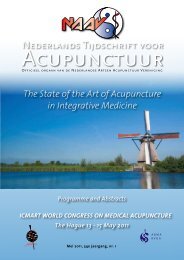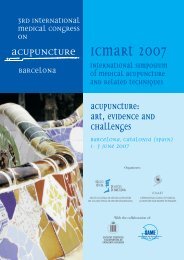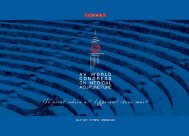Congress Abstracts full PDF - International Council of Medical ...
Congress Abstracts full PDF - International Council of Medical ...
Congress Abstracts full PDF - International Council of Medical ...
Create successful ePaper yourself
Turn your PDF publications into a flip-book with our unique Google optimized e-Paper software.
Workshop 6<br />
NEURALTHERAPY AS INTEGRATIVE MEDICINE IN ENT<br />
Gregor Fischer<br />
Austrian <strong>Medical</strong> Association <strong>of</strong> Neuraltherapy, Krems, Austria<br />
Integrative medicine is a new term that emphasises the combination <strong>of</strong> both conventional and alternative<br />
approaches to address the biological, psychological, social and spiritual aspects <strong>of</strong> health and illness.<br />
Neural therapy (NT) is a holistic method <strong>of</strong> therapy and a technique <strong>of</strong> regulation medicine using local<br />
anaesthetics for local, segmental techniques, injections to ganglions or to nerves.<br />
Main topics in NT are pain therapy, treatment <strong>of</strong> functional diseases and solutions for distur-bance fields.<br />
Working at an ENT-Department with evidence based medicine (EBM) is fined a lot <strong>of</strong> pa-tients who don’t effort on<br />
EBM-therapy. In that case I use NT as integrative medicine. In my lecture I’ll give a selection <strong>of</strong> the principles and<br />
techniques <strong>of</strong> NT especially in the head and neck region.<br />
The main focus will be testing and treatment <strong>of</strong> disturbance fields.<br />
INTRODUCTION IN PRACTICAL NEURAL THERAPY<br />
Wolfgang Ortner<br />
Austrian <strong>Medical</strong> Association <strong>of</strong> Neuraltherapy, H<strong>of</strong>/Lbg., Austria<br />
The main columns <strong>of</strong> the diagnostic procedure are<br />
History Taking, Inspection, Palpation and Functional Examination<br />
History taking<br />
The quality <strong>of</strong> the diagnosis <strong>of</strong> disorders depends to a large extent on targeted and specific history taking. A well<br />
detailed history helps to minimize the number <strong>of</strong> tedious and expensive diagnostic tests required. The first impression<br />
(gait pattern, posture, etc) and the complaints primarily stated (reason for contact) determine the way in which the<br />
experienced therapist directs the exploration.<br />
Inspection:<br />
First look - First impression (Gait pattern, coordination <strong>of</strong> movement),<br />
Stance (body language), First contact (hand grip, eye contact)<br />
Inspection at rest and moving<br />
Palpation:<br />
Palpation <strong>of</strong> connective tissue:<br />
a. Light-touch palpation to realize superficial indications <strong>of</strong> regulatory disorders<br />
b. Connective tissue palpation for tension, subtile swelling and turgor <strong>of</strong> the subcutis.<br />
c. Kibler skin fold rolling as an expression <strong>of</strong> the segmental regulation in the dermatome can give information about<br />
possible pathological conditions <strong>of</strong> the associated myotome, sclerotome or internal organs.<br />
d. In-depth palpation to examine deeper-lying s<strong>of</strong>t tissue structures such as muscular myogeloses, trigger points and<br />
fasciae.<br />
Functional examination<br />
In principle: “From head to foot”<br />
Auxiliary findings<br />
A major competence <strong>of</strong> the therapist is the overview <strong>of</strong> all the findings and the critical assessment <strong>of</strong> auxiliary<br />
findings (diagnostic tests, specialists’ opinions). Physical examination in the form <strong>of</strong> palpation and functional diagnosis<br />
also reveals disorders and pathologies that have not (yet) been established by diagnostic tests. Subtile findings such<br />
as limited tumescence (turgidity) <strong>of</strong> s<strong>of</strong>t tissues may be indicative <strong>of</strong> clinically no apparent disorders. Conversely,<br />
feigned symptoms or falsified diagnostic test results may be called into question as the result <strong>of</strong> s<strong>of</strong>t tissue palpation<br />
void <strong>of</strong> any pathological finding.<br />
Therapeutic procedere<br />
In actual practice the combination <strong>of</strong> various injection techniques is typical. The neural therapist will adapt his<br />
approach to his range <strong>of</strong> experience and training. The effect <strong>of</strong> the therapy will depend less on the type <strong>of</strong> technique<br />
than on an exact examination and the correct inferred biocybernetic idea <strong>of</strong> the disorder. Also simple techniques<br />
prove to be effective if the hypothetic considerations correlate to reality.<br />
47







